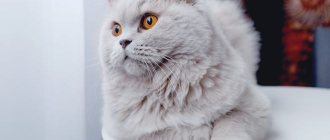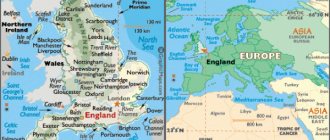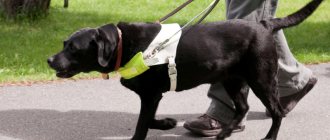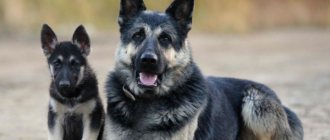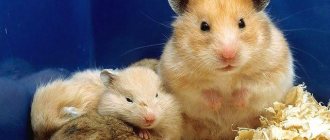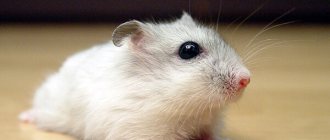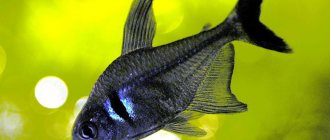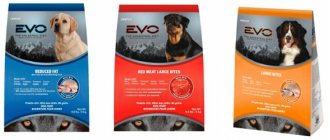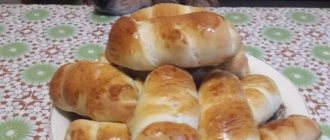The homeland of the Flat-Coated Retriever is Great Britain. The first mentions of representatives of the breed appeared in the 17th century.
The Flat-Coated Retriever is a descendant of the Water Spaniel, Newfoundland and Setter. The direct relationship to the spaniel is evidenced by the type of retriever's muzzle.
The breed standard was written at the end of the 19th century. The breed has not been approved by the FCI for a long time. The current standard approved by the organization appeared in 2009.
Black flat
The Flat-Coated Retriever (Flat) is a hunting dog. His pedigree is a mix of Labrador, spaniel and collie breeds. The Flat differs from its golden counterpart by its straight coat and black color. According to the International Canine Association, there is an approved standard and appearance that all breeders of this dog are guided by.
Appearance and photo
- Country of origin: UK.
- Height: 56-61 cm.
- Weight: 25-36 kg.
- Coat: straight.
- color .
- Life expectancy: up to 10 years.
- Appearance: The Flat gives the impression of being a massive, but at the same time light and fast dog.
Thanks to their fit shape, black retrievers are quick to move and active in action. It is a medium-sized dog with a broad chest, slightly elongated head, slanted brown eyes and long ears. Her paws are straight, even, and muscular. The tail is straight and of medium length. The fur is thick and soft. It is distinguished by its shine, which is noticeable not only on sunny days.
Advantages of the breed:
- versatility;
- obedient character;
- unpretentiousness;
- cheerfulness.
Flaws:
- training requires strength of character;
- the need for frequent long walks and physical activity.
Character traits
Despite its graceful appearance and intelligent eyes, the Flat is not a pampered domestic dog. The retriever, contrary to the luxurious description of the breed’s appearance, is by its nature more suitable for serious work. It is used for hunting by both experienced huntsmen and novice hunters.
Flet gets along well with children, gets along well with other pets, and obeys his owner without further ado. His cheerfulness and cheerful disposition, which last until old age, make him the best friend and companion for the whole family.
Labrador
This breed can be called traditional; in American culture it is even customary to have a Labrador for each newborn child. Dogs are loyal friends and good workers. For this purpose they were bred in Canada at the end of the 19th century.
There are 3 versions of the origin of the name. The first comes from the name of the black rock – labrodorite. The second is from the possible place of origin (Labrador Island). The third is from the Portuguese word “labrador”, which means worker.
The Labrador standard requires 56 cm of height at the withers and no more than 40 kg of weight. But animals love to eat, quickly gain weight and suffer from obesity. In addition, modern Labradors are divided into European and American types: the first is characterized by light shades of coat and an elegant, light body; for the second – golden dark colors and a weighted body. Previously, only black was considered the standard coat color; now wheat and brown are common.
Some of the kindest family dogs in the world . Labradors are always in the top 3 pets for children. They love people, are affectionate and active. The breed is used less and less for hunting, although Retrievers still have natural qualities. They cope well with training, quickly remember commands, are not stubborn, but require education.
Now the dogs either serve in the border guard, or help the disabled, or lie next to the owner on the carpet and play with the child. They can be safely called nanny animals. The average price for a puppy is 25,000-40,000 rubles.
History of the breed
The history of the origin of the Flat-Coated Retriever breed stretches back to the island of Newfoundland. According to one version, Irish spaniels, setters and Gordons were seen in the pedigree of the flats.
There were also Labradors and collies. The final version of the breed was the result of crossing all these species. The very first black retrievers had a curly coat, which later straightened out and acquired a silky sheen.
The peak of popularity of flats came in the middle and end of the 20th century, when their working qualities were widely used by English hunting enthusiasts.
Dimensions, weight and photos of dogs
Main characteristics of the black Labrador:
| Characteristics | Description |
| Adult dog height | 54-57 cm |
| Adult dog weight | 25-40 kg |
| Color | Solid black (resin), white breast option allowed. No other color variations are acceptable in black Labradors: black with mottled spots or tan is considered a disqualifying fault. |
| Wool | Short, dense, hard to the touch, with undercoat. The longhaired Labrador is considered a breeding match. |
| Tail | Very thick at the base, tapering towards the end, evenly covered with thick hair. Can wave happily, but should not curl over its back |
| Torso | Strong build, strong bones |
Also, although the external black color of Labradors is absolutely the same, genetically dogs can carry different colors:
- pure black;
- black and white;
- black, carrying chocolate;
- black carrying fawn;
- black, chocolate-bearing and fawn.
Choosing a puppy
The Flat-Coated Retriever is a hunting dog breed. And this should not be forgotten. He needs frequent walks, trips into nature, and hunting. Therefore, before you decide to purchase such a dog, you should think about whether you will be able to pay so much attention to your future pet.
Before buying a puppy, experts advise visiting a dog show, where you have the opportunity to see different representatives of the breed in real life, talk to breeders, and choose your puppy’s parents.
It is best to buy a baby directly from a nursery. There you can find out all the necessary information about the proper raising of this breed, the pedigree of the puppies, their health and living conditions.
Regardless of the purpose for which you are purchasing a dog: to participate in exhibitions, for hunting, or simply as a pet, you need to assess its physical health. The puppy should have a wet nose, clear eyes and shiny fur.
It is also worth paying attention to the behavior of the animal. A healthy puppy will be active, mobile and without aggression. The cost of a Flat Coated Retriever puppy ranges from $400 to $700 depending on the pedigree.
Pros and cons of the breed
The Flat-Coated Retriever will be an ideal four-legged friend for active people and hunters. Despite his eccentric disposition, the representative of the breed was bred in order to bring small prey. Over time, he began to participate not only in this, but also in searching and capturing small animals and birds.
The advantages of the breed look like this:
- Energy and tirelessness. The dog is ready to accompany the owner in any event, be it a long hike, an active walk or a trip to another city.
- Devotion to the owner and his family members.
- Loyal attitude towards other dogs and cats. If the cat is supportive of the dog’s obsession with wanting to lick her and play with her, the retriever will be very happy about this. When Murka is not particularly loyal to the dog, trying to hit it in the face with a clawed paw or driving it away with a menacing hiss, the dog will switch its attention to something else.
- Friendliness towards strangers.
The straight-coated retriever has more disadvantages than advantages. But, on the other hand, they may seem to someone like the virtues of an animal.
- The representative of the breed grows up very slowly. He is in puppyhood up to 1.5-2 years old, with all the ensuing consequences - the inability to control his emotions and increased loyalty to people.
- They are not at all suitable as a guard dog. The dog is very sociable, and if he sees a thief on his territory, he will regard him as a person who has come for a portion of hugs and kisses.
- Excessive activity can end disastrously for retrievers who are forced to be alone all day long. The dog will find something to do, having tried everything that is within its reach. Clothing, furniture, wires, sockets will undergo a mandatory taste test.
- Animals require long walks. Twice a day, at least 2.5-3 hours. A working person hardly has 5-6 hours of free time to walk his pet.
Where to keep the breed
The ideal place of residence for such an active dog, of course, would be a large country house and a huge yard. There she will be able to give free rein to her unbridled energy and natural instincts.
However, if you provide the retriever with constant exercise and long walks, he will get along well in an apartment. When keeping this breed, one should take into account the fact that the Flat is by nature a tracker, a hard worker and an unsurpassed fetcher.
If all these qualities are satisfied, he will be happy anywhere. This is an ideal pet for active, sporty people, who will happily go with the owner both for a run and for a hunt.
Proper care
Proper care of a pet includes timely hygiene procedures: brushing teeth, ears, combing and washing hair, as well as trimming nails.
Wool
Caring for the coat of a smooth-coated retriever does not cause any difficulties. To keep it looking beautiful and not forming tangles, it is enough to brush your dog once a week. If you do this more often, your pet will only say “thank you.”
During the shedding period, you can do this even more often so that as little fur as possible remains on the furniture and floor.
It is also recommended to treat the dog’s fur with anti-tick spray before sending it hunting and carefully inspect the pet upon returning home. For this procedure, you should choose a special brush for this type of coat.
Bathing
Fletas are crazy about water treatments. Due to the fact that the dog excels in hunting on water, it can bathe for a long time and often. At home, it is enough to wash the retriever once a month to give the coat a natural shine. For this purpose, use shampoo for dogs with long hair.
What to feed your pet
For your dog to always feel great, it is not enough to know how to care for a Flat-Coated Retriever; you will need to feed the animal correctly. The owner is given the choice of feeding dry food or natural products.
When deciding to feed your Flat-Coated Retriever dry food, keep in mind that it is advisable to buy “premium class” food. Their composition is properly balanced and contains the necessary vitamins and minerals. All you have to do is make sure that there is always clean water in your pet’s bowl.
Nutrition based on natural products will require careful selection of the menu. The diet of a Flat-Coated Retriever must include meat. It is advisable to feed dogs natural food with added vitamins. A natural diet includes dairy products, organ meats, vegetables, grains and fruits.
Important! Experts strongly advise against feeding dogs mixed foods: dry food and natural products, even alternating portions of food. It is recommended to feed either the first or the second.
When feeding Flat-Coated Retriever puppies with natural products, keep in mind that the diet of a growing dog is somewhat different.
- During the period of active growth, the young individual receives food rich in calories and calcium.
- In the first months of life, the puppy drinks a sufficient amount of milk.
- Porridge is cooked in milk and meat broth.
- Meat should be present in the diet every day: beef or veal, cut into small pieces.
- Be sure to include fish in the menu. It is permissible to alternate fish days with meat days. It is advisable to give sea fish. If you want to treat your pet to a river catch, be sure to boil it before putting it in the dog’s bowl, and carefully remove small bones.
Education and training
Experienced dog trainers know that training a breed such as the Flat-Coated Retriever is fundamentally different from training other types of retrievers. This dog will never allow you to raise your voice or put pressure on it in any way.
Such treatment will have the opposite effect - the dog will no longer understand what they want from him. If you approach training calmly, the flat will do everything in its power to please its owner.
Training a Flat-Coated Retriever is primarily aimed at developing hunting skills. At the same time, the dog must know the commands well: “Fetch”, “No”, “Ugh”, “Come to me”. This breed is distinguished by its quick wit and intelligence, so it is easy to train and understands its owner perfectly.
Advantages and disadvantages
A versatile, intelligent working dog with many talents, stable, sociable, friendly to everyone at home. The straight-haired is considered the most active among other retrievers, agile, intelligent, with lightning-fast reactions.
These active, hard-working animals constantly need something to do. They are ready to hunt, search or play something constantly. The Flat-Coated Retriever remains a good-natured, gentle, cheerful dog until old age . They are usually very friendly, so using fletts as guards will not work.
According to reviews from owners of straight-coated retrievers, this breed has virtually no disadvantages. Character – easy to train, affectionate, loyal. The appearance is balanced - elegant and powerful at the same time. The only negative is that sometimes there are “too many” pets. A lively temperament constantly forces the dog to look for more and more new adventures. What do you think? Share your experience or observations in the comments.
About the health of the flat
The Flat Retriever, despite its endurance and robust appearance, is predisposed to certain diseases. This:
- problems with hip joints;
- obesity (with a passive lifestyle and unbalanced diet);
- cancer;
- epilepsy;
- heart diseases;
- ear problems.
The black retriever, for its versatility, unpretentiousness, cheerful disposition and obedient character, can be called an ideal pet. And if you decide to become the owner of this cheerful dog, in his form you will find a faithful friend for life.
Life expectancy and illness
The lifespan of a black Labrador, like other Labradors, ranges from 10 to 14 years. As with people, this figure depends on the conditions and lifestyle, nutrition, individual characteristics of a particular individual and diseases to which the Labrador is susceptible and can fall ill.
The Labrador Retriever is a large dog and, first of all, often suffers from joint problems, elbow and knee dysplasia, and in old age, osteoarthritis. These diseases are directly related to the breed's tendency to gain excess weight, which over time puts unnecessary stress on the joints and skeletal system.
Heart and sugar problems are the second most common problems in Labradors.
Much in the physical condition and health of Labradors depends on their owners - if the pet is regularly given a sufficient amount of physical activity, monitors the intake of all necessary substances in its body, and does not overfeed, many health problems can be avoided as much as possible.
Nowadays, all responsible breeders test for dysplasia and other genetic diseases of their dogs before breeding to ensure healthy offspring free from these diseases.
IMPORTANT!
Unfortunately, Labradors are prone to developing cancer and this leads to deaths even among young dogs.
Flat-Coated Retriever: Description of Flat Character
The Flat-Coated Retriever is a hunting dog that stands out for its excellent working qualities and elegant appearance. Representatives of the breed are often called Flat-Coated Retrievers, Hairy Labradors, or Flat-Coated Retrievers. For many years, dogs were used to hunt waterfowl because... they were famous for their incredible speed, reaction and courage. Labradors, spaniels and collies took part in the development of the straight-coated retriever as an independent breed. The key external feature is the straight coat and black or black-brown coloring.
It is important to note that in the recent past the breed was not used for hunting purposes, because Then spaniels coped with this too. But over time, the flat retriever began to prove itself as an experienced and devoted hunter who can catch and catch almost any bird. When choosing a companion, experienced hunters will definitely give preference to this delightful pet.
The ancestors of the flat retriever , which is found today, were gun retrievers, which were characterized by an amazing sense of smell and the ability to find game in the most inaccessible places. True fans of this breed, engaged in hunting, proposed crossing and breeding a new hunter.
Officially, smooth-coated retrievers were registered only at the beginning of the 20th century. During the war and post-war times, the demand for representatives of the breed dropped significantly. People began to choose Labradors, but now the popularity of the former is renewed again.
Curly-Coated (Curly-Coated)
This Retriever is different from his brothers. The breed is the rarest of the group and the most non-contact. It began to be bred at the beginning of the 19th century on the island of Newfoundland. Curley's ancestors: Irish Spaniel, Newfoundland, Setter, Poodle.
At first, dogs served fishermen and helped on ships until aristocrats noticed them. Breeders decided to improve hunting qualities and got a discreet, strong Retriever
Since 1860 the animals have been kept as pets and hunting dogs . Since the 20th century, the breed was brought to Australia and New Zealand, where Curly-Coated Terriers are now popular, unlike Russia and other Eurasian countries.
Retrievers are standard in format: an elongated rectangular body, dry limbs, a square muzzle and a round head. Their fur can be brown or reddish in color, and is curled into tight strands.
This is an intelligent and strong working dog that is ready to train and serve people faithfully. She does not show aggression, but does not like the pranks of children and is wary of strangers. Curleys need the owner's firm hand, leadership, and good upbringing. Otherwise, in a circle of people, the Retriever will be embarrassed, lost, and angry.
The breed is not intended for living in an apartment, living with a small child or elderly people. Curley needs an avid hunter or an active family willing to devote time to frequent walks and exercise the pet. The average cost of a puppy is 15,000 rubles.
Origin story
the birthplace of the Flat-Coated Retriever . Oddly enough, but on this small piece of land the largest number of amazing dogs were bred, which gained worldwide recognition. The final external and physical features were formed in England.
There is an opinion that the smooth-haired retriever was bred by crossing Irish water spaniels with setters and Gordons. In the modern breed you can notice the properties of collies, small Newfoundlands and Labradors.
The first individuals were distinguished by thick, wavy hair, due to which they received the name wavy-coated retrievers. In the 19th century, dogs were in demand among aristocrats and the upper classes who were fond of hunting.
But the first straight-coated retrievers had one drawback - their coat was not thick enough and did not protect the pet from water penetration. To solve the problem, a series of complex breeding activities had to be carried out, as a result of which a new breed with straight and thick hair was developed.
Until the end of the 19th century, the Flat-Coated Retriever was the favorite companion of elite hunters from England. They were soon replaced by Labradors and Golden Retrievers, which surpassed the Flats in their performance characteristics. Many hunters have forgotten about the existence of such an amazing breed.
If Mr. Shirley, a fan of the straight-coated retriever, had not opened the first kennel of these dogs in the 20th century, perhaps they would have completely disappeared and would not have survived to this day. This is also due to the merit of Dr. Bond Moore, who made a large investment in popularizing and creating a standard for flat retrievers.
From the first days the breed was popular among English gamekeepers, because... she was famous for her hard work and excellent search properties.
Price issue
The straight-coated flat retriever is a commercial exotic and an exquisite rarity, but finding a puppy of good blood is quite possible: there are nurseries for toothy hunters in large cities, and the breeding centers are full of proposals for the sale of young animals. If you have the desire and financial capabilities, you can also implement foreign shopping.
The price of a charming baby starts at $800 - a lot depends on the articles and exhibition qualifications of the parents, the class and prospects of the puppy.
Description of the Flat-Coated Retriever, character traits
Visually, the Flat Retriever is a graceful and strong pet, with beautiful fur, a muscular neck and lively eyes. But it is not suitable for home use as a “toy”. This breed is designed to perform complex tasks and serious work, which is why it is still used by hunters and gamekeepers all over the world. An obedient character and high intelligence turns the pet into an indispensable assistant for all occasions.
Unlike other varieties of retriever, the smooth-haired breed is considered universal. Key character traits include:
- well-developed intellect;
- courage;
- endurance;
- excellent instinct;
- ability to work both on land and in water;
How the Flat-Coated Retriever breed is used at work
Since dogs are not prone to aggression, they are not suitable for defense or for guarding territory. Their best qualities as a gun dog are shown during the hunt.
They are also used as guide dogs for the visually impaired, as a companion dog. A sensitive sense of smell allows the breed to be used to search for missing people. In order to detect people under the rubble and call rescuers. Such a dog will be of great use at customs and in the police. A sensitive sense of smell makes it easy to detect drugs or explosives.
Dogs were used in World War I to help wounded soldiers on the battlefield. They participated in laying communication lines and undermining enemy equipment.
The bright appearance of flats makes them indispensable participants in exhibition shows.
Black Flat-Coated Retriever: photo.
Types and standard
Externally, the Flat-Coated Retriever looks like a harmonious, powerful and playful animal with average height and the characteristics of a gun dog. The dog's behavior is accompanied by positivity and optimism. Full maturity of the breed ends at the age of three, but friendliness and playfulness accompanies the dog throughout the remaining years of its life. The pet shows its kind attitude towards people by wagging its tail.
Dog breeders and dog handlers who train retrievers note that this breed has an improved lower sense of smell, which allows it to quickly determine the location of prey and not be distracted by other birds. Dogs also have a large reserve of strength, which is very important when transporting birds from long distances. Unlike many other hunting dogs, the Wavy Labrador has excellent eyesight and can spot where game has fallen.
The dog is not afraid of exposure to cold temperatures, so he can dive into the water even in the cold season. But most hunting trips take place in the fall or winter. In pursuit of a bird, the Flat-Coated Retriever sees no obstacles. He may be black with dirt and wet with water, but he will still reach his goal and bring the shot bird to the hunter, keeping it in the same condition as he found it.
The characteristics of the breed are determined by the following characteristics:
- The birthplace of the breed is Great Britain;
- The height of an adult male is 58-61 cm at the withers, and the weight is 25-35 kilograms; in females these figures reach 56-59 centimeters in height, and there are practically no differences in weight;
- The chest is wide and the body is quite muscular;
- The shape of the head looks elongated or solid. Prilobiye is not clearly expressed. If this is not the case, the dog may be disqualified from the purebred group. The muzzle cannot be strongly lowered or upturned;
- The setting of the eyes is slightly oblique. Round shaped eyes are not acceptable;
- The iris may be brown or light brown;
- The paws are straight and have excellent muscles;
- The coat is medium, soft and straight. The dog becomes completely covered with hair only after it has fully matured;
- Color – black, there are also specimens of liver color (liver color);
- The ears are medium-length and fit snugly to the head and cheeks;
- The maximum life expectancy reaches 10 years;
Thoroughbred representatives create the impression of a playful and cheerful pet, with a fit physique and medium size. The fur of a healthy adult shines and shimmers, even without sunlight. The absence of key features of the standard can be a disadvantage. In this case, the dog may be disqualified.
It is important to note that yellow dogs are sometimes shown at shows. This strange color is associated with genetic abnormalities. This certainly does not affect the character and performance indicators, although such representatives are not used for breeding.
Nicknames and names
Following the tenets of cyberlinguistics, the name of a pet has a direct impact on the owner of the animal, and not just on him. After all, the nickname sounds many times even throughout the day. The combination of sounds causes particles to vibrate at a certain wave frequency, forming a mood and a certain kind of association.
The characteristics of sound also include the color factor, since color also has a wave nature. The ratio of major-minor, dark-light is the tonality, and quiet-loud, dim-bright is an indicator of the strength of the sound and the intensity of the light flux.
The names have not only a musical nature, but also color characteristics. The sound O displays a white and light yellow glow, A – deep red, I – blue.
The euphony of names and nicknames is perceived subconsciously by humans, and consciously by animals. Therefore, names for dogs are chosen that are euphonious, short, reflecting the pet’s character traits and influencing the fate of those around them. The main thing is that the name is to the liking of its bearer.
Since the nickname is already included in the pedigree, it is advisable to know its origin, who it was worn by, as well as the fate of the one whose name the dog will bear
This is very important, since dogs tend to accept the inheritance of a tragic name
Features of care
Due to its courageous nature, the flat is easy to care for. He is taught to live in Spartan conditions, to endure frost, rain, dampness and other weather conditions. A Flat-Coated Retriever will not be able to develop normally in an apartment environment, so he needs regular walks and intense physical activity. For people leading an inactive lifestyle, purchasing such a pet will be a problem.
Representatives of the Flat-Coated Retriever breed are intelligent, athletic and graceful dogs. With proper training and proper care, this pet will become the most loyal companion and will be able to behave both in society and in the wild.
Character and behavior
Flat-haired retrievers are cheerful and friendly dogs, designed to interact with people. They easily become attached to their owners and treat all household members equally well. Cheerful and energetic flats are always in a great mood and try to charge others with positivity.
They retain their puppy-like spontaneity until old age and play little pranks throughout their lives.
On a note. Emotional and sociable, Flat-Coated Retrievers do not like to be left alone for long periods of time. Fletas who interact closely with their owners become nervous and disobedient.
Versatile, Flat-Coated Retrievers have proven themselves to be hardy and hard-working hunters. Fletas have no fear of water and have a keen sense of smell. Thanks to the ability to swim and dive, they can hunt both swamp and waterfowl.
Flat-coated retrievers do not show aggression towards strangers and are not suitable for guard duty. But if necessary, dogs will warn their owners about the approach of strangers by barking loudly, and in case of danger they will be able to stand up for themselves and their family.
Breed and children
Soft and affectionate, flat cats get along well with children. They willingly play outdoor games with them and take part in joint walks.
On a note. Energetic and active Flat-Coated Retrievers can accidentally drop a child when playing too hard. Therefore, it is dangerous to leave them alone with preschoolers and primary schoolchildren.
Breed and other animals
Non-conflict and friendly Flat-Coated Retrievers easily find a common language with their non-aggressive relatives. But for small domestic animals, flats can be dangerous due to their developed hunting instincts.
Flat retriever
Lifespan: 10 years
Litter: 4-8 puppies (average 6)
Group: Sports
Recognized by: CKC, FCI, AKC, UKC, ANKC, NKC, NZKC, APRI, ACR
Coat color: black or liver color
Hair length: long
Shedding: moderate
Size: Large
The Flat-Coated Retriever is a hunting dog breed descended from the Labrador Retriever, Collie and Spaniel. The difference from other retrievers is their straight coat and brown, but more often black, color.
History of the breed
In the 19th century, with the improvement of firearms and the widespread art of shooting at flying birds, sportsmen began to feel the need for a special dog that would find the shot bird and bring back the kill, instead of the setters, pointers and spaniels that were widely used for this purpose. The main producers for this new type of working dog were probably small Newfoundlands or Labradors (a large water dog that was brought to England by fishermen and sailors), large spaniels, setters and pointers. With certain crossing of these dogs and consistent selection, a uniform type was obtained dogs called the "wavy-coated retriever". Along with the curly-haired retriever, it became extremely popular among huntsmen and sports hunters. These "wavy-coated retrievers" gave rise to the Flat-Coated Retriever breed. It is likely that collie blood was infused into them in the late 1890s to produce a more beautiful coat. Breed enthusiasts at the time put a lot of effort into improving the Flat, and from the late 1800s until World War 1 they were the most popular retrievers.
At shows at the turn of the 19th and 20th centuries, Flats, Labradors and Goldens were all presented in the same class. But, later, in 1903, Labradors were recognized as a separate breed. In 1911, Goldens were also recognized as a separate breed. And in 1911, 146 Labradors were registered along with 400 flats. But by 1926, both Goldens and Labradors outnumbered the Flats. In those years, interbreeding among retrievers was allowed due to the lack of blood within the breeds. Since 1911, black color was steadily bred in flats, and brown color began to be cultivated in 1930, and in 1940 it was adopted as the second main color of the breed. Due to interbreeding of retrievers, black and chocolate flats were and remain carriers of the fawn gene. The fawn color in flats is not recognized and is a defect. However, a few white hairs on the chest and between the toes are not uncommon in the breed and are quite acceptable.
Historical reference
The Flat-Coated Retriever developed quietly until the outbreak of the First World War. Numerous breeders who cultivated the universal gun dog worked for themselves and did not show the results to the public. The first known breeder was Mr. Shirley, who put a lot of effort into standardizing and disseminating the breed. Moreover, Shirley opened one of the largest kennels of Flat-Coated Retrievers.
After World War I, the breed's popularity declined sharply as it had to compete with the more famous gun dogs. The breed's population has decreased critically, but enthusiasts and fans have taken up the task of restoring it. In the 60s of the 20th century, the breed's population was brought out of the crisis, although it did not fully recover.
This is interesting! Modern breeders consider the small common breed a plus, since control is important for quality breeding work.
Due to its rarity and a long list of hereditary diseases, the Flat-Coated Retriever is not yet recognized by the World Canine Federation. The breed is bred in the USA. Puppies are very rarely exported outside of America, not to mention the fact that potential owners reserve puppies more than a year before birth.
Health
The Flat Retriever is a very hardy breed with excellent health. It is necessary to constantly maintain his health with the help of a balanced diet and specially designed training. He is prone to cancer, so to avoid disastrous consequences, check his heredity (did his parents have such diseases!) and take him to the veterinarian for regular checkups. Problems may also arise with: • hereditary hip dysplasia, which can lead to severe lameness; • diabetes; • epilepsy; • Deafness: Congenital deafness can be a big problem. The most common cancers are malignant hemangioma (hemangiosarcoma), fibrosarcoma (fibrosarcoma), malignant histiocytosis (histiocytosis) and osteosarcoma (osteosarcoma). These diseases are more common in Flat-Coated Retrievers than in other breeds. 75% of dogs die from cancer.
The Flat Retriever's coat should be trimmed, clean and neat. It requires weekly combing. Intensive care is necessary when the dog is caught in the rain or has been outside for a long time in low temperatures. To keep the coat shiny (it shines differently throughout the year), brushing at least 4-5 times a week is ideal. Shedding is moderate. The coat gets tangled easily, so be careful when brushing. Taking a bath (+shampoo) is necessary when your dog is very dirty. The retriever is cleaned regularly. A visit to the veterinarian once a month will be helpful to monitor your pet's health.
Nutrition
When feeding a Flat dog with industrial food, you should give preference either to premium products, supplementing them with essential vitamins and microelements, or to super-premium food.
Supporters of natural feeding will find the following table useful, which shows what products should be fed to the animal and when.
| No. | Products | Feeding frequency |
| 1 | Meat | Daily |
| 2 | Multivitamins | |
| 3 | Vegetables | |
| 4 | Fruits | |
| 5 | By-products | 2-3 times a week |
| 6 | Sea fish | 1 time every two weeks |
| 7 | Cottage cheese | |
| 8 | Milk | Puppies 2-3 months old daily |
Important! Alternating dog food prepared by the owner with industrial food is strictly contraindicated.
Activity
The Flat Retriever needs training throughout the day. Jogging, long-distance running, walking, playing with a Frisbee are ideal activities for this breed. He loves to swim and hunt, so take him to the park or forest where he can explore a lot. He loves speed and car rides, so take him camping with you. A born hunter, the Flat-Coated Retriever has an excellent sense of smell. If your dog falls behind you during a walk, don’t worry: he will never get lost. The Flat Retriever is very smart and always listens carefully to everything you tell him. Therefore, it is important to be consistent and encourage his actions during training. This breed enjoys getting things done.
Tips for choosing a puppy
Let us immediately warn you that it is best to buy a straight-coated retriever in a nursery or from professional breeders who specialize in breeding such animals. Only there can you be given any guarantees that the puppy you purchased has a stable psyche, good health and working qualities. To decide on a breeder or kennel, you can visit specialized exhibitions and personally communicate with dog breeders.
It is equally important to decide for yourself why exactly you need a puppy of this breed. If you do not plan to participate in exhibitions, then you can safely be guided by personal sympathies and buy the dog you like. If you expect that the acquired straight-coated retriever puppy will grow into a real champion and breeding sire, you need to take the issue of choice more seriously. In this case, you should carefully study the baby’s pedigree and, if necessary, seek help from experts.
When choosing a puppy, it is important to pay attention not only to its appearance, but also to its behavior. He must be active, curious and cheerful. A good puppy with a stable psyche and working abilities will never show signs of cowardice or aggression.
Training
The Flat Retriever is so emotional and energetic that he can easily bump into something, damage something, and not realize his size when greeting small children. Therefore, he needs training. The Flat Retriever was bred as a sporting breed, which is why it is so active. Vary the exercises, change toys and equipment: he quickly gets bored of doing the same thing.
He enjoys learning at any age. If the retriever does everything correctly during training and easily remembers new things, then offer him a treat, a new toy, or a walk in the park as a reward. He wants to please his owner with his behavior. He is very loyal and sociable. During training, use only positive methods. Be consistent. He will not do anything if you scold him or behave harshly. You can easily turn your retriever into an excellent hunting dog.
This will make the most of his natural abilities. He is very strong, resilient, and has excellent scent, which is very important when hunting. The first thing you should start training him with is to develop his ability to chase. Everything must be shown, otherwise the retriever will not understand you. Using games will give good results during learning. The retriever enjoys spending as much time as possible with its owner. He responds to his love with devotion, attention, and affection.
Attitude towards children and others
Nova Scotia Toller Retriever: description of the breed
Representatives of the above breed of dogs get along well with babies and love to lick them. True, pets, showing their good feelings, are so emotional and hyperactive that they can easily knock a child to the floor without the slightest malicious intent.
Important! Any joint games between a flat dog and a child are permissible only in the presence of an adult.
Retrievers will always be happy to meet new people. The dogs will smile good-naturedly at their new friend, want to hug his legs and lick him. But not all passersby will admire such a manifestation of feelings.
Seeing a cat in sight, a flat will definitely want to get to know it so that it can play later. The dog will certainly chase her. The cat, deciding that it is in danger, will try to run away. The “hairy labrador” will set off after her. For the above reasons, the Flat-Coated Retriever can only be walked outside on a leash.
Habitat
Flats are very lively and emotional dogs, unusually loving small children. They are "frantic lickers" and have extreme affection and adoration. They need your attention and get very bored when they are away from you for a long time. They love water in all its forms - from the smallest muddy puddle to a river or sea, and they can feel it over very long distances! If you don’t raise a little flat, then later he will grow up to be independent and with a demanding character. But if you raise him properly, he will be an excellent dog in any field - for home and family, for hunting, for agility, for shows, as well as a dog for the deaf and a foster dog for hospitals and nursing homes.
Flats make delightful lifelong companions as they are always happy and never seem to age. Flats are never in a bad mood, even a sick dog will show their love and friendliness. They constantly collect things, from slippers, pillows and underwear to sticks and stones. Let them carry something that isn't dangerous because that's what they have to do. BUT BE CAREFUL - flats can swallow objects they play with! Always reward them when they bring you something and praise them when they give it to you. Don't forget that they were bred to seek and fetch, and this innate instinct should not be interfered with. NEVER chase them while they are holding something in their mouth as they may interpret this as an invitation to play!
Sources:
https://pets2.me/bok/618-chernyy-volosatyy-labrador-ohotnichya-poroda-sobak-pryamosherstnyy-retriver.html https://zveri.guru/zhivotnye/sobaki/porody-sobak/pryamosherstnyy-retriver-opisanie -haraktera-fleta.html https://moypitomets.com/poroda/flet-retriver
Life support and grooming
Smooth-haired retrievers do not feel very comfortable in huge megacities and do not tolerate the pressure of man-made infrastructures. Flats are simple “guys from the outback”, lovers of “country style”, fans of free spaces and everyday life in the field. The optimal placement of the dog is open placement in a warm kennel with free access to the fenced yard and living area of a country mansion.
These are very freedom-loving and sociable animals; even a short stay in an enclosure (a chain is strictly contraindicated for flat retrievers) has a negative impact on the psyche and disposition of a hunting dog.
The innate working talents and instincts of the Flat-Coated Retriever are simply amazing: the dogs are constantly on the move, monitoring the surroundings, carrying something in their mouths, digging holes and trenches, and splashing in the water at the slightest opportunity. These are cheerful and cheerful natural perpetuum mobile, toothy energizers, never aging Peter Pans.
In urban localization, accommodation in a large studio apartment, it is necessary to organize dynamic walking for the animal, an active promenade and mandatory physical activity. Low motor load of flat retrievers will definitely result in depression, a lot of diseases and destructive behavior. It’s great if the owner has a “house in the village” and the opportunity to systematically (on weekends) take the dog “on leave” out of town: for a flat-coated retriever, this format of life support is considered quite positive and appropriate.
Organization of the lifestyle and maintenance of a large hunting dog: the issue is the owner’s personal time and willingness to spend this most valuable resource on a pet. This dog is for active people, huntsmen, athletes, travelers. Created exclusively for hunting, strong and smart dogs excel in sports disciplines (flyball, agility).
Hygienic grooming
The Flat-Coated Retriever breed does not need exotic spa treatments and grooming delights. All hygiene comes down to brushing the fur a couple of times a week, weekly cleaning of the ears and fangs, bathing (when dirty) and trimming the claws. When combing, close attention should be paid to the decorative fur on the paws and tail, as well as under the arms, where it “has the habit” of rolling into tangles.
Exhibition grooming
Preparing a dog for an exhibition catwalk includes a wide range of procedures. First stage: bathing using special (mild) detergents and thoroughly drying using a hairdryer. For dark dogs, you should choose a gentle, anti-allergenic shampoo with conditioner. Thorough drying is not a whim, but an urgent necessity: a damp (under-dried) undercoat will provoke dermatitis, weeping eczema, and folliculitis. First, a well-absorbing towel, then a hairdryer while combing/styling.
A show straight-coated retriever needs a haircut that accentuates its silhouette and enhances its elegant appearance. Professional groomers joke: trimming will not turn an “unexpressive” flat into a “handsome” one, but it will certainly transform a good format into a magnificent one.
On breed forums, the question is often discussed: is it necessary to trim a working flat dog, a dog that does not take part in exhibition activities. The most satisfying answer for everyone is the statement that retrievers like to be beautiful and well-groomed, and this is beneficial in the heat.
The main thing is to accustom your pet to hygienic measures and exhibition grooming for about five months, so that the little flat gets used to the clicking of scissors, the hum of the machine and the painful but necessary fuss. In principle, this is absolutely not difficult: straight-haired hunters love to be in the epicenter of home life and perceive grooming as a form of communication, a manifestation of attention.
Food basket
The daily menu of a pet depends on the owner: knowledge, preferences and financial capabilities format the diet and implement the feeding model. The expert community recommends several basic rules, development vectors, and standards:
- premium industrial feed from reputable manufacturers;
- absolute removal of complementary foods from the “master’s table” and neighbors’ trash heaps;
- systematic control weighings and consultations with a veterinarian nutritionist;
- enhanced control of the tone and condition of the dog when changing the usual food range (switching to therapeutic/age/gender diets).
The diet of a hunting dog is the first thing that requires special attention from the owner. Working commercial animals consume a huge amount of energy: the commercial menu should be rich in carbohydrates, proteins, fat, vitamins and mineral components.
Overfeeding a dog is unacceptable: overeating instantly provokes metabolic disorders, obesity, shortness of breath, and a series of dangerous pathologies. The diet is consciously increased only during “field” trips, during periods of seasonal molting, during the prevention and treatment of diseases, during pregnancy and lactation of bitches.
Training and training
Flat retrievers are dogs that are amazingly easy to train: dogs grasp the meaning of commands, the essence of requirements, the boundaries of prohibitions and freedoms from the first try. “Smooth” dogs like to work, they are appropriate and quite convincing in OKD, sports disciplines, and hunting training.
The main thing is to take into account the personal characteristics of the flat dog breed : behind the cheerful and friendly disposition hides a vulnerable and fragile essence, a dog that cannot tolerate rudeness, cruelty and unjustified pressure. Education, social adaptation, training and field training must be built on the innate talents of the breed and the “highlights” of the character. It is necessary to diversify trainings, turn pedagogical litigation into a game, transform exercises into a dog demonstrating his articles and talents. Flats love to please their owner with success: these charming fishermen love to shine and bask in the rays of admiration and glory.
With the right approach and patience, a Flat puppy can easily be transformed into a controlled, hardworking retriever, a versatile gun dog, a faithful companion, and a loving friend.
Health
The flat dog is a hardy animal, bursting with health and has a strong immune system. A caring and responsible owner is only required to support what nature has given him with high-quality life support and veterinary services.
Unfortunately, representatives of the flat family have a tendency to:
- to joint dysplasia;
- to diabetes mellitus;
- to hearing pathologies (deafness);
- to oncology: malignant histiocytosis, osteogenic sarcoma.
Problems can be avoided when purchasing a puppy: most of the diseases mentioned are hereditary. The norm is that the breeder requires gene tests of the parents and verification of the heredity of the offspring.
Everything else: standard medical examination in a veterinary clinic at the place of residence, seasonal vaccination and an anthelmintic action plan.

